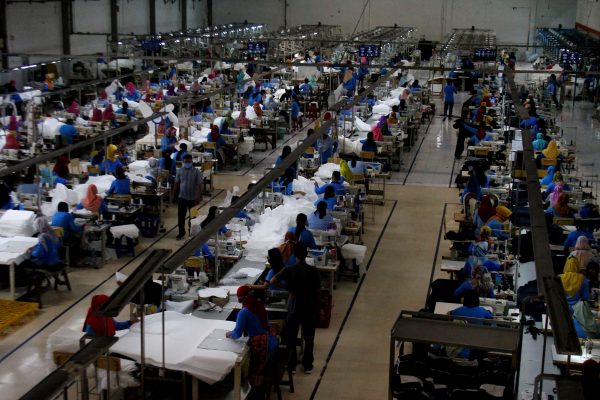Unlike previous crises, COVID-19 is not only affecting the demand side of manufacturing, but also the supply side. Lockdowns and social distancing measures are significantly reducing global demand for clothing products and disrupting production and global value chains. There are also concerns about clusters of COVID-19 cases in garment factories.
In the United States, apparel retail sales dropped by 88 per cent in April 2020, compared to the same month in 2019. Major brands — such as Adidas, GAP and H&M — experienced massive sales drops, shop closures and lower stock prices while many manufacturers faced order cancellations. In the first quarter of 2020, clothing imports in the United States, the European Union and Japan — the three largest importers of clothing products — fell by 12 per cent, 8 per cent and 10 per cent respectively compared to the same quarter in 2019.
The Indonesian economy is highly dependent on garment exports — in 2019 the sector contributed 11 per cent to total manufacturing exports and 5 per cent to total exports. It employs 5.2 million workers — mostly medium skilled, low paid and female.
In May 2020, Indonesia’s textile and textile product exports dropped by a massive 52 per cent compared to the same month in 2019. This continues a worsening trend since March and April 2020 — when exports declined by 14.6 and 38.9 per cent respectively compared to the previous year. The largest export drop of 51 per cent is to the US market, the destination of 60 per cent of Indonesian garments.
Domestic retail sales of clothing have also declined by 74 per cent. The substantial slump in both export and domestic markets may induce factory closures and put millions of people out of work, sending millions of people into poverty. While domestic sales might improve after social distancing measures abate, export sales are likely to continue to worsen until global demand recovers.
The pandemic is also disrupting the supply side as many firms close or utilise their factories lower than production capacities. Under Indonesia’s social distancing restrictions, factories need permits from the government to conduct activities with certain protocols and health standards. These labour-intensive firms must maintain physical distancing between workers by reducing the number of workers in one shift — many workers were simply laid-off as a result.
Supply constraints are starting to ease as the government relaxes these restrictions. Meanwhile, the increase in demand for protective equipment could encourage some garment firms to switch their production. But they still face many challenges around standards, technologies and inputs.
COVID-19 is not the only issue facing Indonesia’s garment sector. Exports have been declining since 2019 — albeit modestly — with total garment exports dropping by around 4 per cent. While some of the problems were caused by weakening global demand, poor government policies are also to blame.
The Indonesian garment sector is highly dependent on imported inputs, which range from 18 to 30 per cent of the sector’s production costs. Despite this dependence, the government is applying increasingly higher tariffs and non-tariff barriers to the imported inputs. While there are mechanisms to get exemptions or reimbursement for imported input tariffs for exported products, many textile and garment products are not eligible.
A 2015 Ministry of Trade regulation (85/2015) requiring government approval for imports on a range of textile and textile products was made more stringent in 2017 (64/2017) and then again in 2019 (77/2019), requiring all textile imports to be approved by the Ministry. In 2019, temporary safeguard tariffs were applied to textile inputs (Ministry of Finance Regulation 162/2019 and 163/2019). In May 2020, the government announced a renewal of the safeguard tariffs on 107 types of fabrics and six types of yarns.
These well-intended policies to support textile input producers may increase business costs and lower the garment sector’s competitiveness even further — adding to the burden of COVID-19. Considering the textile industry’s importance in creating jobs and supporting Indonesia’s long-term development, the government should implement policies to ensure the sector’s survival.
In the short term, working environments must remain COVID-19-free when factories reopen. New COVID-19 clusters endanger any hope of a speedy recovery. This also depends on the country’s ability to stop the virus from spreading.
The government needs to remove existing raw material import restrictions and fight the push from interest groups to implement new ones. Even without these restrictions, the sector faces challenges from competition with other developing countries such as Bangladesh and Vietnam. Vietnam, the third-largest global textile exporter, imports 89 per cent of its textile inputs. Indonesia’s import restriction policies at least partially explain its low export competitiveness.
If the sector is to survive the pandemic and recover from the slump, it needs to regain its competitive edge. This includes addressing long-term issues in labour and investment regulations, as well as high gas prices, which forms 25 per cent of the upstream textile industry cost structure. While the government is overhauling these regulations through the controversial omnibus bill, it is still unclear how it will solve the gas price issue.
Ultimately, the survival of the Indonesian textile industry depends on global economic recovery. Given its uncertainty, the government should not unnecessarily burden textile businesses.
Dr Deasy Pane is a planner at the Indonesian Ministry of National Development Planning (Bappenas).
Donny Pasaribu is a PhD scholar at the Crawford School of Public Policy, The Australian National University.
This article is part of an EAF special feature series on the novel coronavirus crisis and its impact.

